check engine BMW 330i TOURING 2001 E46 Owner's Manual
[x] Cancel search | Manufacturer: BMW, Model Year: 2001, Model line: 330i TOURING, Model: BMW 330i TOURING 2001 E46Pages: 203, PDF Size: 2.07 MB
Page 10 of 203

Contents
Overview
Controls and features
Cockpit16
Instrument cluster18
Indicator and warning lamps20
Multifunction steering wheel
(MFL)24
Sports steering wheel25
Hazard warning flashers26
Warning triangle26
First-aid kit26
Refueling27
Fuel specifications28
Tire inflation pressure28
Opening and closing:
Keys32
Electronic vehicle
immobilizer33
Central locking system34
Opening and closing Ð
from the outside34
Opening and closing Ð
from the inside38
Tailgate38
Cargo area40
Alarm system41
Electric power windows43
Sliding/tilt sunroof44
Adjustments:
Seats46
Seat and mirror memory49
Steering wheel50
Mirrors51
Car Memory, Key Memory52
Passenger safety systems:
Safety belts53
Airbags55
Transporting children safely58
Driving:
Steering/Ignition lock61
Starting the engine61
Switching off the engine62
Parking brake63
Manual transmission64
Automatic transmission with
Steptronic65
Turn signal indicator/
Headlamp flasher68
Washer/Wiper system68
Rear window defroster70
Cruise control71
Everything under control:
Odometer73
Tachometer73
Energy Control73
Fuel gauge74
Coolant temperature gauge74
Service Interval Display74
Check Control75
Clock75
Computer76
Technology for safety and
driving convenience:
Park Distance Control (PDC)78
Automatic Stability Control plus
Traction (ASC+T)79
Dynamic Stability Control
(DSC)80
Tire Pressure Control (RDC)85
Page 19 of 203
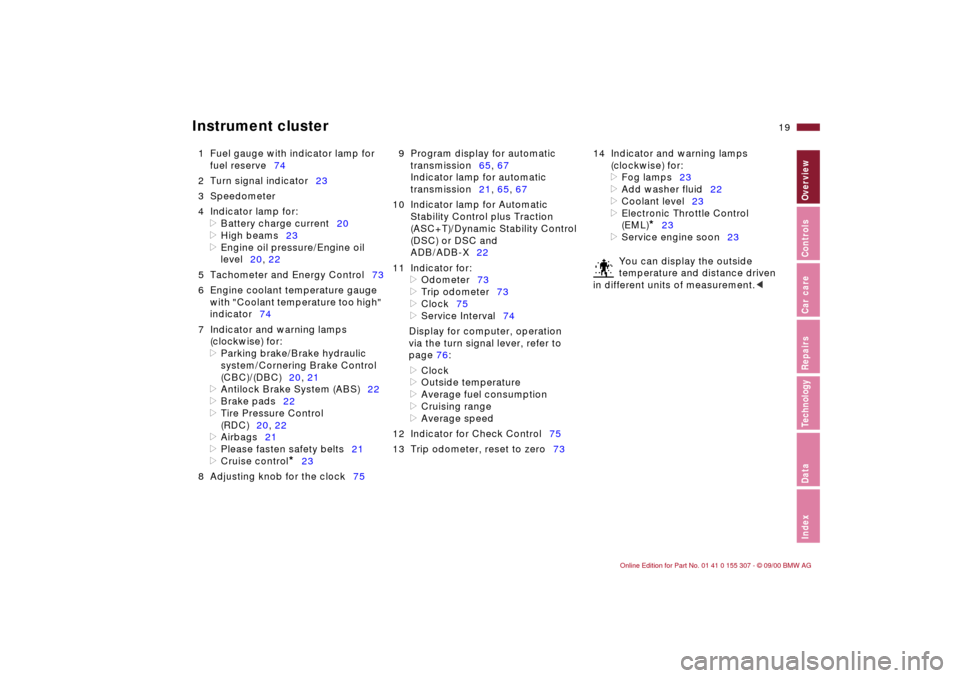
19n
IndexDataTechnologyRepairsCar careControlsOverview
Instrument cluster
1 Fuel gauge with indicator lamp for
fuel reserve74
2 Turn signal indicator23
3 Speedometer
4 Indicator lamp for:
>
Battery charge current20
>
High beams23
>
Engine oil pressure/Engine oil
level20, 22
5 Tachometer and Energy Control73
6 Engine coolant temperature gauge
with "Coolant temperature too high"
indicator74
7 Indicator and warning lamps
(clockwise) for:
> Parking brake/Brake hydraulic
system/Cornering Brake Control
(CBC)/(DBC)20, 21 >
Antilock Brake System (ABS)22
>
Brake pads22
>
Tire Pressure Control
(RDC)20, 22
>
Airbags21
>
Please fasten safety belts21
>
Cruise control
* 23
8 Adjusting knob for the clock759 Program display for automatic
transmission65, 67
Indicator lamp for automatic
transmission21, 65, 67
10 Indicator lamp for Automatic
Stability Control plus Traction
(ASC+T)/Dynamic Stability Control
(DSC) or DSC and
ADB/ADB-X22
11 Indicator for:
>
Odometer73
>
Trip odometer73
>
Clock75
>
Service Interval74
Display for computer, operation
via the turn signal lever, refer to
page 76:
>
Clock
>
Outside temperature
>
Average fuel consumption
> Cruising range >
Average speed
12 Indicator for Check Control75
13 Trip odometer, reset to zero7314 Indicator and warning lamps
(clockwise) for:
>
Fog lamps23
>
Add washer fluid22
>
Coolant level23
>
Electronic Throttle Control
(EML)
*
23
>
Service engine soon23
You can display the outside
temperature and distance driven
in different units of measurement.
<
Page 20 of 203
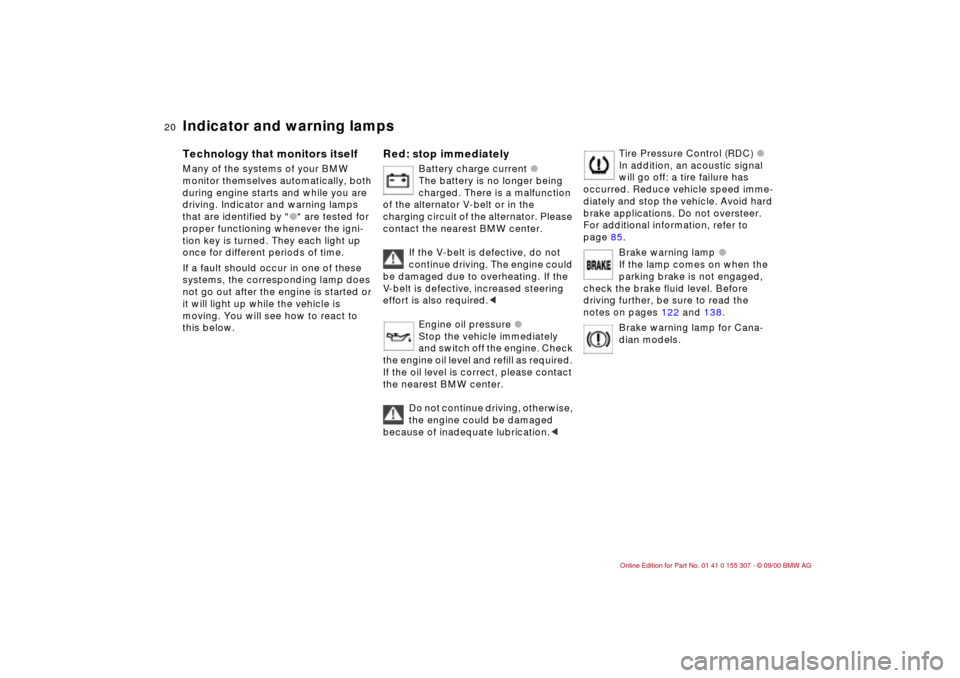
20n
Indicator and warning lamps
Technology that monitors itself
Many of the systems of your BMW
monitor themselves automatically, both
during engine starts and while you are
driving. Indicator and warning lamps
that are identified by "
l
" are tested for
proper functioning whenever the igni-
tion key is turned. They each light up
once for different periods of time.
If a fault should occur in one of these
systems, the corresponding lamp does
not go out after the engine is started or
it will light up while the vehicle is
moving. You will see how to react to
this below.
Red: stop immediately
Battery charge current
l
The battery is no longer being
charged. There is a malfunction
of the alternator V-belt or in the
charging circuit of the alternator. Please
contact the nearest BMW center.
If the V-belt is defective, do not
continue driving. The engine could
be damaged due to overheating. If the
V-belt is defective, increased steering
effort is also required.
<
Engine oil pressure
l
Stop the vehicle immediately
and switch off the engine. Check
the engine oil level and refill as required.
If the oil level is correct, please contact
the nearest BMW center.
Do not continue driving, otherwise,
the engine could be damaged
because of inadequate lubrication.
<
Tire Pressure Control (RDC) l
In addition, an acoustic signal
will go off: a tire failure has
occurred. Reduce vehicle speed imme-
diately and stop the vehicle. Avoid hard
brake applications. Do not oversteer.
For additional information, refer to
page 85.
Brake warning lamp l
If the lamp comes on when the
parking brake is not engaged,
check the brake fluid level. Before
driving further, be sure to read the
notes on pages 122 and 138.
Brake warning lamp for Cana-
dian models.
Page 22 of 203
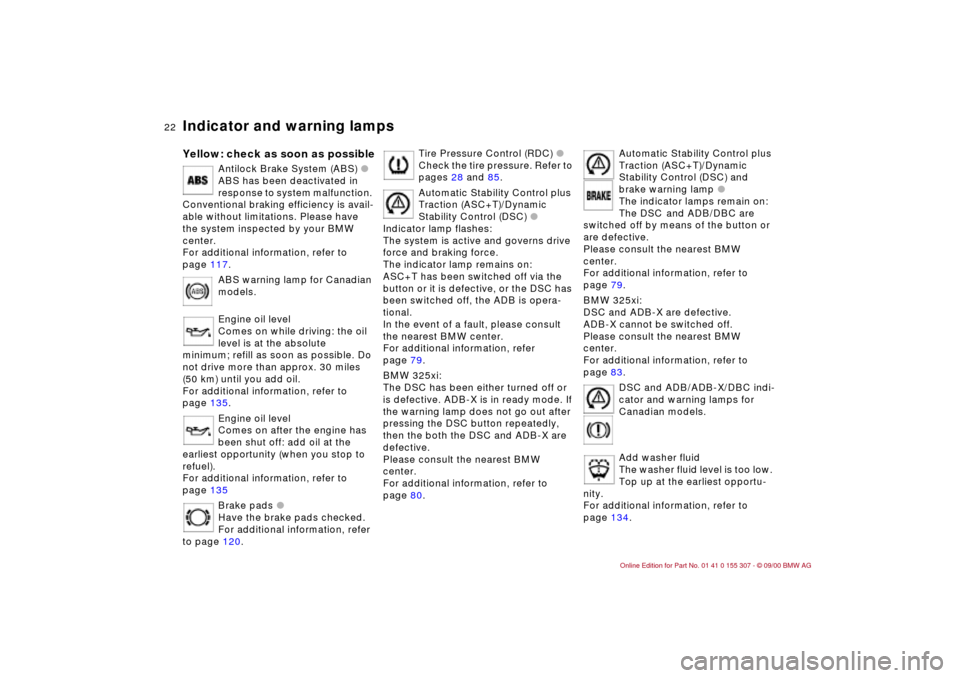
22n
Indicator and warning lampsYellow: check as soon as possible
Antilock Brake System (ABS) l
ABS has been deactivated in
response to system malfunction.
Conventional braking efficiency is avail-
able without limitations. Please have
the system inspected by your BMW
center.
For additional information, refer to
page 117.
ABS warning lamp for Canadian
models.
Engine oil level
Comes on while driving: the oil
level is at the absolute
minimum; refill as soon as possible. Do
not drive more than approx. 30 miles
(50 km) until you add oil.
For additional information, refer to
page 135.
Engine oil level
Comes on after the engine has
been shut off: add oil at the
earliest opportunity (when you stop to
refuel).
For additional information, refer to
page 135
Brake pads l
Have the brake pads checked.
For additional information, refer
to page 120.
Tire Pressure Control (RDC) l
Check the tire pressure. Refer to
pages 28 and 85.
Automatic Stability Control plus
Traction (ASC+T)/Dynamic
Stability Control (DSC) l
Indicator lamp flashes:
The system is active and governs drive
force and braking force.
The indicator lamp remains on:
ASC+T has been switched off via the
button or it is defective, or the DSC has
been switched off, the ADB is opera-
tional.
In the event of a fault, please consult
the nearest BMW center.
For additional information, refer
page 79.
BMW 325xi:
The DSC has been either turned off or
is defective. ADB-X is in ready mode. If
the warning lamp does not go out after
pressing the DSC button repeatedly,
then the both the DSC and ADB-X are
defective.
Please consult the nearest BMW
center.
For additional information, refer to
page 80.
Automatic Stability Control plus
Traction (ASC+T)/Dynamic
Stability Control (DSC) and
brake warning lamp l
The indicator lamps remain on:
The DSC
and ADB/DBC are
switched off by means of the button or
are defective.
Please consult the nearest BMW
center.
For additional information, refer to
page 79.
BMW 325xi:
DSC and ADB-X are defective.
ADB-X cannot be switched off.
Please consult the nearest BMW
center.
For additional information, refer to
page 83.
DSC and ADB/ADB-X/DBC indi-
cator and warning lamps for
Canadian models.
Add washer fluid
The washer fluid level is too low.
Top up at the earliest opportu-
nity.
For additional information, refer to
page 134.
Page 23 of 203
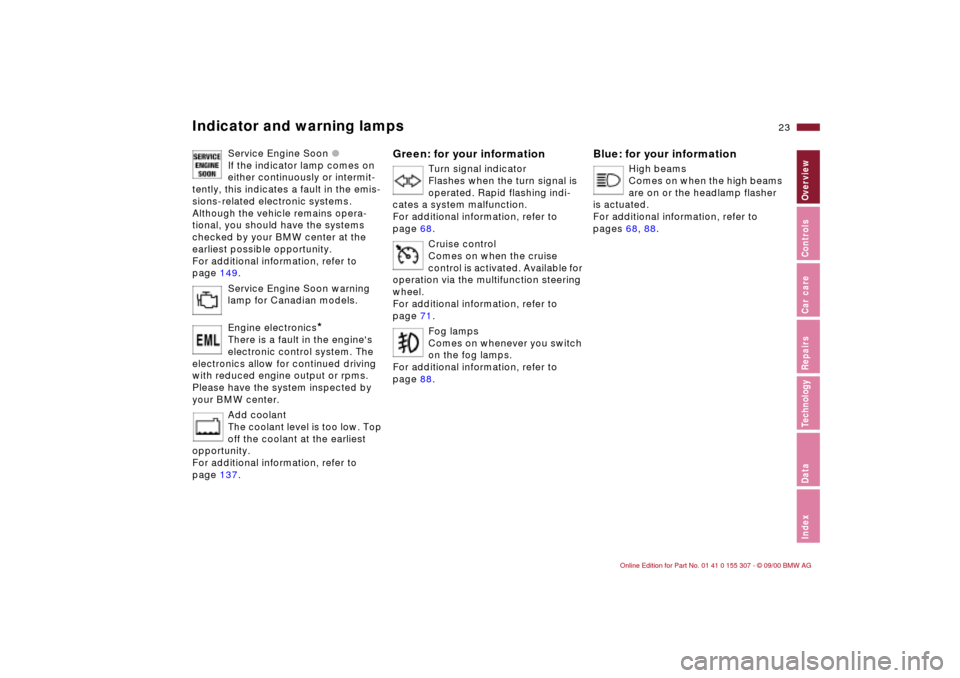
23n
IndexDataTechnologyRepairsCar careControlsOverview
Indicator and warning lamps
Service Engine Soon l
If the indicator lamp comes on
either continuously or intermit-
tently, this indicates a fault in the emis-
sions-related electronic systems.
Although the vehicle remains opera-
tional, you should have the systems
checked by your BMW center at the
earliest possible opportunity.
For additional information, refer to
page 149.
Service Engine Soon warning
lamp for Canadian models.
Engine electronics
*
There is a fault in the engine's
electronic control system. The
electronics allow for continued driving
with reduced engine output or rpms.
Please have the system inspected by
your BMW center.
Add coolant
The coolant level is too low. Top
off the coolant at the earliest
opportunity.
For additional information, refer to
page 137.
Green: for your information
Turn signal indicator
Flashes when the turn signal is
operated. Rapid flashing indi-
cates a system malfunction.
For additional information, refer to
page 68.
Cruise control
Comes on when the cruise
control is activated. Available for
operation via the multifunction steering
wheel.
For additional information, refer to
page 71.
Fog lamps
Comes on whenever you switch
on the fog lamps.
For additional information, refer to
page 88.
Blue: for your information
High beams
Comes on when the high beams
are on or the headlamp flasher
is actuated.
For additional information, refer to
pages 68, 88.
Page 28 of 203
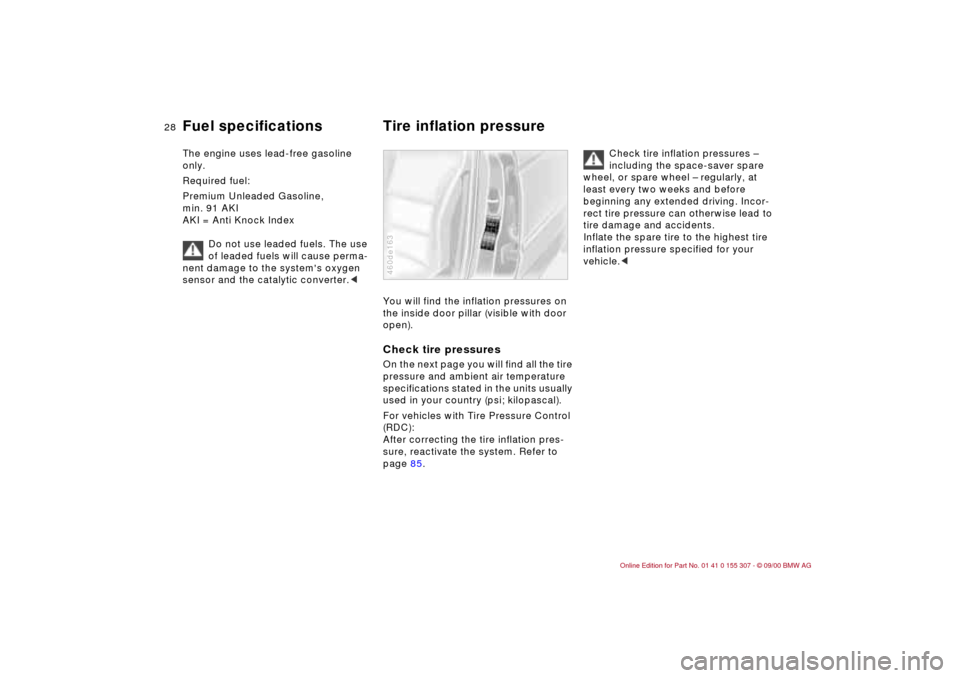
28n
Fuel specifications Tire inflation pressure The engine uses lead-free gasoline
only.
Required fuel:
Premium Unleaded Gasoline,
min. 91 AKI
AKI = Anti Knock Index
Do not use leaded fuels. The use
of leaded fuels will cause perma-
nent damage to the system's oxygen
sensor and the catalytic converter.<
You will find the inflation pressures on
the inside door pillar (visible with door
open).Check tire pressures On the next page you will find all the tire
pressure and ambient air temperature
specifications stated in the units usually
used in your country (psi; kilopascal).
For vehicles with Tire Pressure Control
(RDC):
After correcting the tire inflation pres-
sure, reactivate the system. Refer to
page 85.460de163
Check tire inflation pressures Ð
including the space-saver spare
wheel, or spare wheel Ð regularly, at
least every two weeks and before
beginning any extended driving. Incor-
rect tire pressure can otherwise lead to
tire damage and accidents.
Inflate the spare tire to the highest tire
inflation pressure specified for your
vehicle.<
Page 31 of 203
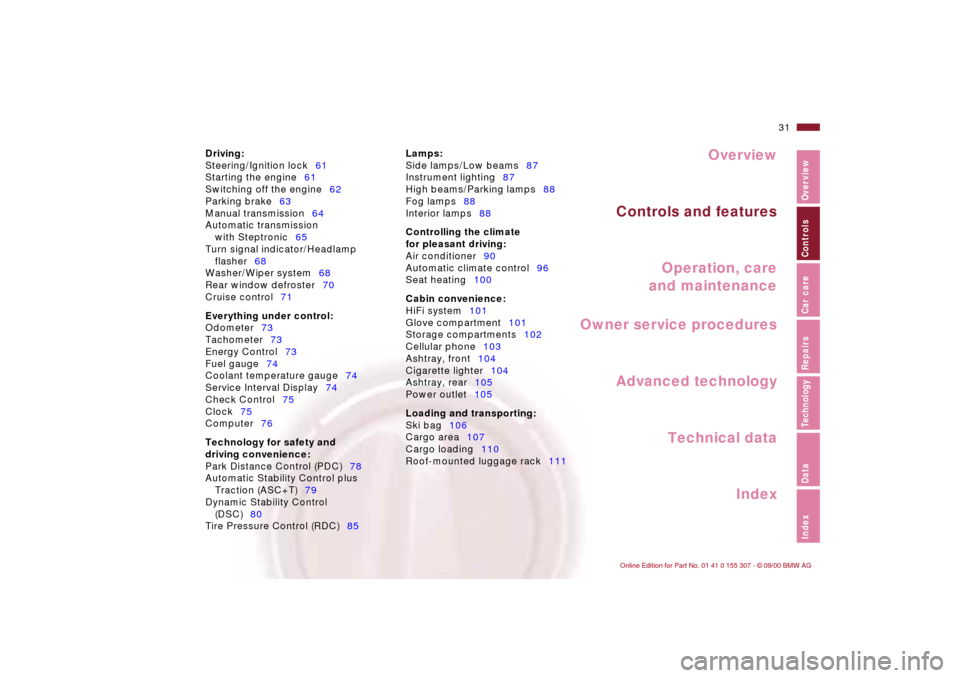
Overview
Controls and features
Operation, care
and maintenance
Owner service procedures
Technical data
Index Advanced technology
31n
IndexDataTechnologyRepairsCar careControlsOverview
Driving:
Steering/Ignition lock61
Starting the engine61
Switching off the engine62
Parking brake63
Manual transmission64
Automatic transmission
with Steptronic65
Turn signal indicator/Headlamp
flasher68
Washer/Wiper system68
Rear window defroster70
Cruise control71
Everything under control:
Odometer73
Tachometer73
Energy Control73
Fuel gauge74
Coolant temperature gauge74
Service Interval Display74
Check Control75
Clock75
Computer76
Technology for safety and
driving convenience:
Park Distance Control (PDC)78
Automatic Stability Control plus
Traction (ASC+T)79
Dynamic Stability Control
(DSC)80
Tire Pressure Control (RDC)85Lamps:
Side lamps/Low beams87
Instrument lighting87
High beams/Parking lamps88
Fog lamps88
Interior lamps88
Controlling the climate
for pleasant driving:
Air conditioner90
Automatic climate control96
Seat heating100
Cabin convenience:
HiFi system101
Glove compartment101
Storage compartments102
Cellular phone103
Ashtray, front104
Cigarette lighter104
Ashtray, rear105
Power outlet105
Loading and transporting:
Ski bag106
Cargo area107
Cargo loading110
Roof-mounted luggage rack111
Page 73 of 203
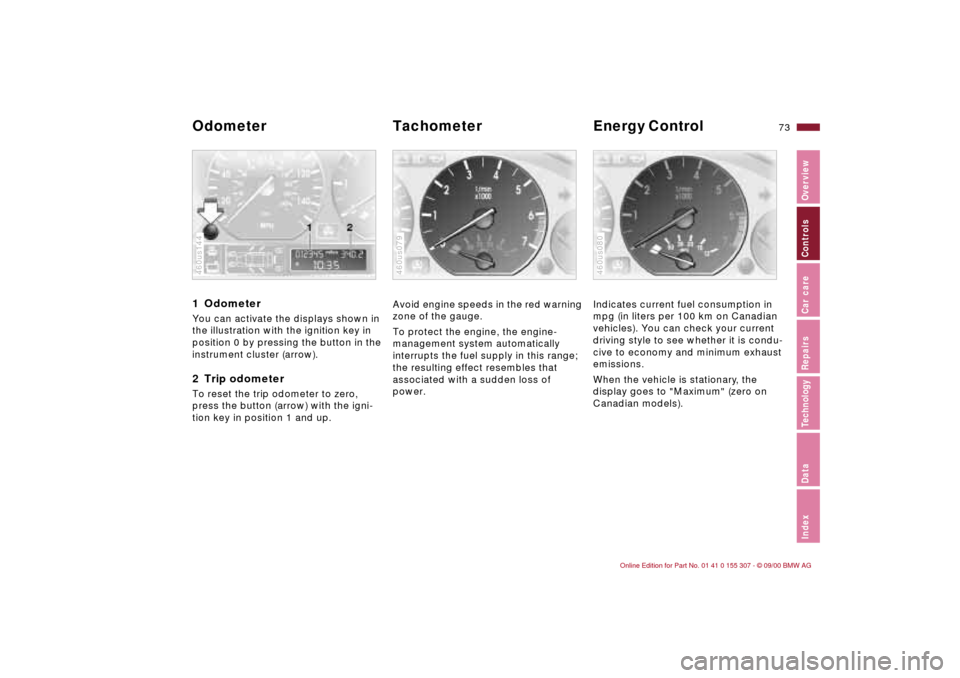
73n
IndexDataTechnologyRepairsCar careControlsOverview
1 Odometer You can activate the displays shown in
the illustration with the ignition key in
position 0 by pressing the button in the
instrument cluster (arrow).2 Trip odometerTo reset the trip odometer to zero,
press the button (arrow) with the igni-
tion key in position 1 and up.460us144
Avoid engine speeds in the red warning
zone of the gauge.
To protect the engine, the engine-
management system automatically
interrupts the fuel supply in this range;
the resulting effect resembles that
associated with a sudden loss of
power.460us079
Indicates current fuel consumption in
mpg (in liters per 100 km on Canadian
vehicles). You can check your current
driving style to see whether it is condu-
cive to economy and minimum exhaust
emissions.
When the vehicle is stationary, the
display goes to "Maximum" (zero on
Canadian models).460us080
Odometer Tachometer Energy Control
Page 74 of 203
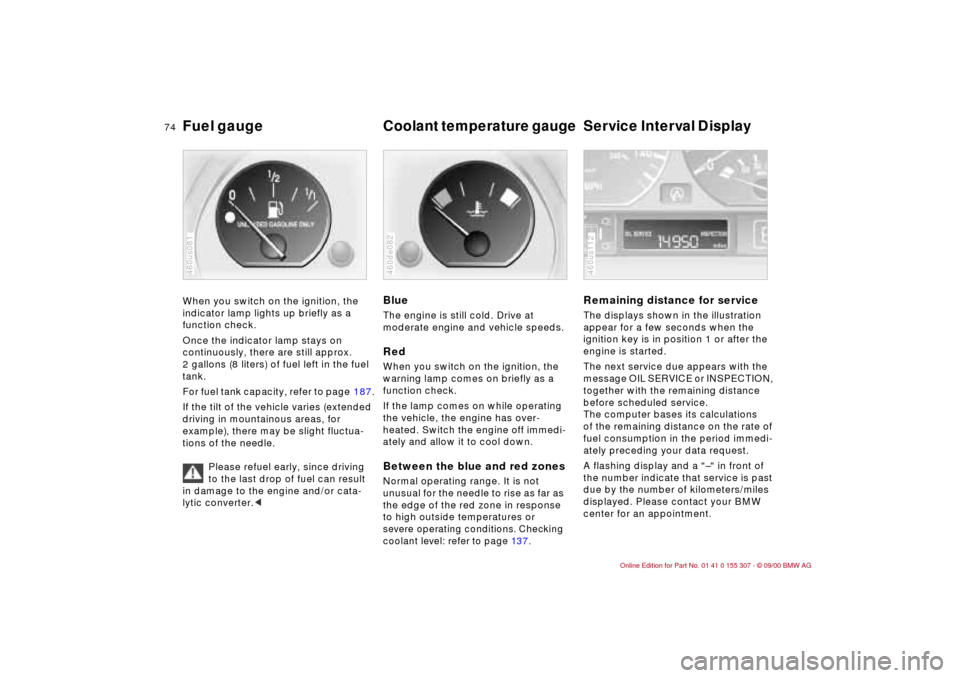
74n
Fuel gauge
Coolant temperature gauge
Service Interval Display
When you switch on the ignition, the
indicator lamp lights up briefly as a
function check.
Once the indicator lamp stays on
continuously, there are still approx.
2 gallons (8 liters) of fuel left in the fuel
tank.
For fuel tank capacity, refer to page 187.
If the tilt of the vehicle varies (extended
driving in mountainous areas, for
example), there may be slight fluctua-
tions of the needle.
Please refuel early, since driving
to the last drop of fuel can result
in damage to the engine and/or cata-
lytic converter.<460us081
BlueThe engine is still cold. Drive at
moderate engine and vehicle speeds.RedWhen you switch on the ignition, the
warning lamp comes on briefly as a
function check.
If the lamp comes on while operating
the vehicle, the engine has over-
heated. Switch the engine off immedi-
ately and allow it to cool down.Between the blue and red zonesNormal operating range. It is not
unusual for the needle to rise as far as
the edge of the red zone in response
to high outside temperatures or severe operating conditions. Checking
coolant level: refer to page 13 7.460de082
Remaining distance for serviceThe displays shown in the illustration
appear for a few seconds when the
ignition key is in position 1 or after the
engine is started.
The next service due appears with the
message OIL SERVICE or INSPECTION,
together with the remaining distance
before scheduled service.
The computer bases its calculations
of the remaining distance on the rate of
fuel consumption in the period immedi-
ately preceding your data request.
A flashing display and a "Ð" in front of
the number indicate that service is past
due by the number of kilometers/miles
displayed. Please contact your BMW
center for an appointment.460us112
Page 85 of 203
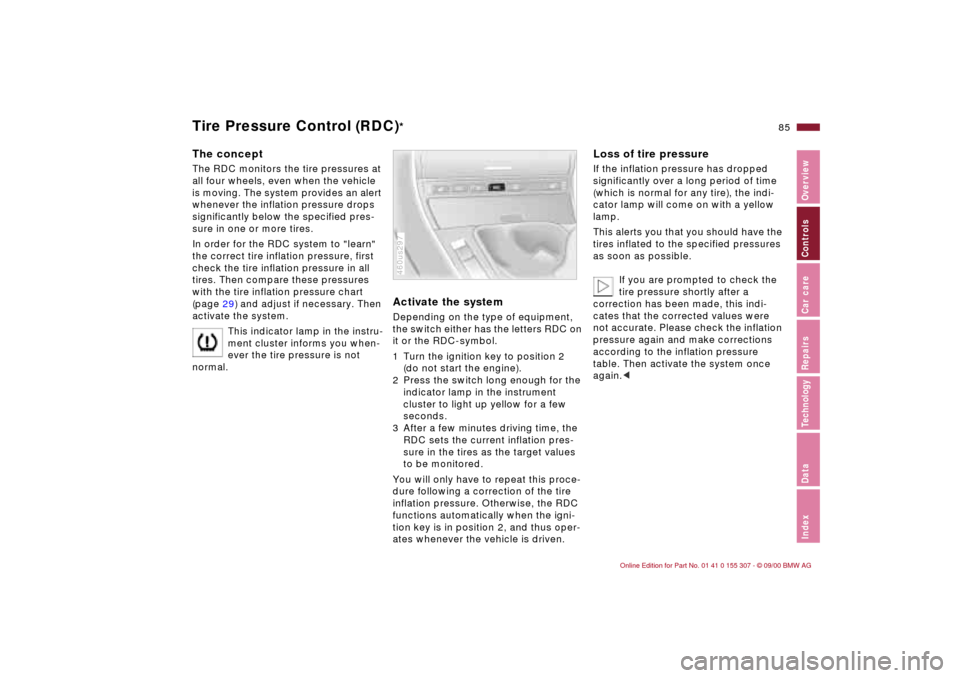
85n
IndexDataTechnologyRepairsCar careControlsOverview
Tire Pressure Control (RDC)
*
The conceptThe RDC monitors the tire pressures at
all four wheels, even when the vehicle
is moving. The system provides an alert
whenever the inflation pressure drops
significantly below the specified pres-
sure in one or more tires.
In order for the RDC system to "learn"
the correct tire inflation pressure, first
check the tire inflation pressure in all
tires. Then compare these pressures
with the tire inflation pressure chart
(page 29) and adjust if necessary. Then
activate the system.
This indicator lamp in the instru-
ment cluster informs you when-
ever the tire pressure is not
normal.
Activate the system Depending on the type of equipment,
the switch either has the letters RDC on
it or the RDC-symbol.
1 Turn the ignition key to position 2
(do not start the engine).
2 Press the switch long enough for the
indicator lamp in the instrument
cluster to light up yellow for a few
seconds.
3 After a few minutes driving time, the
RDC sets the current inflation pres-
sure in the tires as the target values
to be monitored.
You will only have to repeat this proce-
dure following a correction of the tire
inflation pressure. Otherwise, the RDC
functions automatically when the igni-
tion key is in position 2, and thus oper-
ates whenever the vehicle is driven.460us297
Loss of tire pressureIf the inflation pressure has dropped
significantly over a long period of time
(which is normal for any tire), the indi-
cator lamp will come on with a yellow
lamp.
This alerts you that you should have the
tires inflated to the specified pressures
as soon as possible.
If you are prompted to check the
tire pressure shortly after a
correction has been made, this indi-
cates that the corrected values were
not accurate. Please check the inflation
pressure again and make corrections
according to the inflation pressure
table. Then activate the system once
again.<